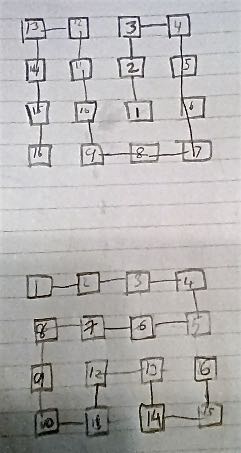Skip over navigation
There are many different things to explore in this problem. Rebecca, Bethany, Ben and James from Gateway Primary School looked at finding the totals of the each row and column in their caterpillar arrangements. What a good idea!
Yajat from Hewson Public School in Canada said:
I was able to make three more patterns of caterpillar
and sent in the following picture:

Daniel wrote to say:
We did some caterpillars, and in all the different ones we did each medium square (made up of four squares inside our big square) added up to an even number, and all the rows and all the columns did too.
All the 9-square squares in our big square added up to odd numbers. We think that is because there was an odd number of squares in those squares, and because of the caterpillars being odd then even then odd then even.
Thank you for these contributions.

Or search by topic
Number and algebra
Geometry and measure
Probability and statistics
Working mathematically
Advanced mathematics
For younger learners
Caterpillars
Age 5 to 7
Challenge Level 





- Problem
- Getting Started
- Student Solutions
- Teachers' Resources
There are many different things to explore in this problem. Rebecca, Bethany, Ben and James from Gateway Primary School looked at finding the totals of the each row and column in their caterpillar arrangements. What a good idea!
Yajat from Hewson Public School in Canada said:
I was able to make three more patterns of caterpillar
and sent in the following picture:

Daniel wrote to say:
We did some caterpillars, and in all the different ones we did each medium square (made up of four squares inside our big square) added up to an even number, and all the rows and all the columns did too.
All the 9-square squares in our big square added up to odd numbers. We think that is because there was an odd number of squares in those squares, and because of the caterpillars being odd then even then odd then even.
Thank you for these contributions.
You may also like
Let's Investigate Triangles
Vincent and Tara are making triangles with the class construction set. They have a pile of strips of different lengths. How many different triangles can they make?

